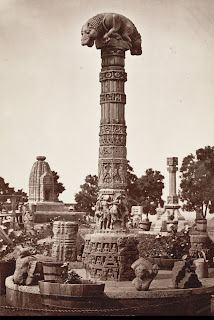The Gurjara-Pratihara dynasty was an imperial power during the Late Classical period on the Indian subcontinent, that ruled much of Northern India from the mid-8th to the 11th century. They ruled first at Ujjain and later at Kannauj. The Gurjara- Pratiharas were instrumental in containing Arab armies moving east of the Indus River. The power of their army effectively prevented the progress of the Arab Muslims invaders for nearly three hundred years, and this is regarded as their chief contribution to the history of India.
Gurjara- Pratihara Coin, showing image of God Vishnu in his Boar (Varaha) incarnation with a human body and a boar's head, rescuing the earth. Issued by King Mahendrapala I, (885-910 AD). In British Museum, London.
The origin of the Gurjars and particularly the Gurjara-Pratiharas are derived from the word ''pratihara'' which in Sanskrit means ''doorkeeper''. They are seen as a tribal clan of the Gurjars.
Nagabhata I (739-760 AD), the first ruler, was originally a feudatory of the Chavdas of Bhillamala. He gained prominence after the downfall of the Chavda kingdom, in the process of resisting the invading Arabs. Nagabhata I, extended his control east and south from Mandor to Malwa, to Gwalior and the port of Bharuch in Gujarat. He established his capital at Avanti in Malwa and checked the expansion of the Arabs, established in Sindh.
Gurjara-Pratihara Empire, 900 ADIn the battle in 738 AD, Nagabhata defeated the Arabs who had till then been pressing on victorious through west Asia and Iran. This is inscribed on the ''Gwalior inscription'' that the Arab invading army had anywhere between 10-15,000 cavalry, 5000 infantry and 2000 camels. The Arab chronicler Sulaiman describes the Army of Pratiharas as it stood in 851 AD, ''The ruler of Gurjars maintains numerous forces and no other Indian prince has so fine a cavalry''.
Under Mihira Bhoja and his successor Mahendrapala I, the extent of its territories rivalled that of the Gupta Empire stretching from the border of Sindh in the west to Bengal in the east and from the Himalayas in the north to areas past the Narmada in the south.
The expansion triggered a tripartite power struggle with the Rashtrakuta and Pala empires for control of the Indian subcontinent. During this period, Imperial Pratihara took the title of ''Maharajadhiraja of Aryavarta'' (Great King of Kings of India.
The power of the Pratiharas was weakened by dynastic strife. It was further diminished as a result of a great raid led by the Rashtrakuta ruler Indra III who, in about 916 AD, caused destruction to Kannauj. Their feudatories became more and more powerful, and resisted their allegiance until, by the end of the 10th century, they merely controlled the Gangetic Doab. Their last important king, Rajapala, was driven from Kannauj by Mahmud of Ghazni in 1018 AD. Jasapala, the last Gurjara-Pratihara ruler of Kannauj died in 1036 AD.
Entrance of the Teli ka Mandir, built by Mihira Bhoja
Gurjara-Pratihara are known for their sculptures, carved panels and open pavilion style temples. The oldest surviving Jain temple was built by King Vatsaraja in 738 AD at Osian in Jodhpur District of Rajasthan, as per the inscription found at Sachiya Mata Temple, at Osian, dating back to 956 AD.
Obverse: Varaha (boar incarnation of God Vishnu) facing right
Obverse: Varaha (Boar incarnation of God Vishnu) to right, various Vaishnavite symbols including Trident to left and wheel under the foot
Reverse: Symbols and two lines legend, ''srimad adi / varaha
Obverse: Varaha (Boar incarnation of God Vishnu), to right
Reverse: Legend in three lines ''srimad vinayaka deva''
Obverse: Varaha (Boar incarnation of God Vishnu) to right, vaishnavite symbols
Reverse: Two-line legend ''srimad adi / varaha
















Truly informative and inspiring.
ReplyDeleteOur knowledge of our own history is quite off the mark and skewed.
Thanks